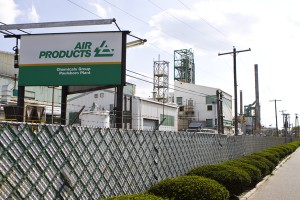EPA School Air Toxics Data Misleading

Paulsboro High School - Valero refinery and Air Products chemical plant in background. Note the direction of plume from stack - pollution is being blown directly toward school. I could strongly smell volatile organic chemicals. After just 15 minutes shooting these pictures, I was nauseous and had a headache and dry scratchy throat.

Senate Envrionment Committee Chair Barbara Boxer (D-Ca.) questions Lisa Jackson at EPA confirmation hearing about kid's exposure to toxics at school, as documented by USA Today series.
EPA today released interim air toxics monitoring results at two NJ schools participating in a new national program that is monitoring air quality around 63 schools in 22 states
The new EPA program was a response to major investigative reports by the Houston Chronicle (“In Harm’s Way”) and USA Today (“Toxic Air and America’s Schools”) that documented serious health threats due to exposure to toxic air pollutants, particularly to children from chemical plants and refineries located close to schools (read this for background) and (this for Senator Boxer’s commitment at EPA Administrator Jackson’s confirmation hearing)
The initial NJ results are misleading.

Valero refinery emits toxic air pollutants, just feet upwind from Paulsboro high school
First off, if you read the EPA press release below, you wouldn’t know that the NJ schools (Paulsboro High School and Mabel Holmes Middle School in Elizabeth) are located very close to and virtually surrounded by chemical plants and refineries that emit thousands of pounds of volatile organic toxic air pollutants to the local air.
Second, if you looked at the initial sample results, you might conclude that everything is OK – , until you realize that EPA sampled mostly for heavy metals, not volatile organic compounds (VOC’s) and chemicals emitted by the chemical plants and refineries. Those VOC pollutants are “yet to be monitored” according to EPA. EPA sampled for
| Antimony (Nanograms/cubic meter) | 2000 | — | — | 4.08 |
| Arsenic (Nanograms/cubic meter) | 150 | — | — | .71 |
| Beryllium (Nanograms/cubic meter) | 20 | — | — | .06 |
| Cadmium (Nanograms/cubic meter) | 30 | — | — | .15 |
| Cobalt (Nanograms/cubic meter) | 100 | — | — | .27 |
| Formaldehyde (Micrograms/cubic meter) | 50 | 3.23207 | 2.96171 | 5.05088 |
| Manganese (Nanograms/cubic meter) | 500 | — | — | 8.51 |
| Mercury (Nanograms/cubic meter) | 3000 | — | — | .02 |
| Propionaldehyde (Micrograms/cubic meter) | 80 | .38742 | .43971 | .65125 |
| Selenium |
This is especially troubling, because not only do these results mislead the public by creating a false appearance that there is no problem, but the results will be used by EPA “to help determine next steps, which could include more monitoring, if needed”.
That’s right – EPA could say that based on these results, there is no problem and no further sampling, permit modification, or enforcement to reduce pollution are required.

Air Products chemical plant just feet away from Paulsboro High School. Prevailing westerly winds blow toxic pollution from this plant directly into school.
The lies and excuses have already been framed to spin this data.
First, the oil and chemical industries are suggesting that the risk are negligible and the sources of pollutants are mobile sources – cars and trucks. We doubt the EPA sampling protocol will be able to distinguish between sources, so EPA is not challenging this lie. Worse, these facilities are issued permits under the Clean Air Act, so EPA knows exactly what hazardous air pollutants are being emitted by those facilities. These hazardous air pollutants should have been targeted and the first ones sampled, not metals. Second, EPA – as per below press release – will stress chronic long term exposure risks to downplay the risks of any high level local VOC results.
We Await the VOC monitoring.
Update:
I just looked at the full list of EPA monitored pollutants at schools. EPA is monitoring for just 3 VOC’s! This is a pathetic whitewash – the Clean Air Act regulates 187 chemicals as hazardous air pollutants – check out EPA’s June 2009 National ambient air toxics data and statewide NJ cancer risks here).
As I suspected, the few pollutants EPA is monitoring all involve naturally occurring sources of pollution, or are related to vehicle exhaust or mobile sources. This seems designed to allow the chemical & oil industries to make the argument that industry emissions are not the problem and to point the finger at mobile sources and naturally occurring sources. EPA could have considered the hazardous air pollutants emitted by nearby refinery and chemical plants (in EPA air permit data), and then designed a monitoring scheme that included those pollutants. That way, EPA would have a solid scientific basis to modify air permits to force facilities to reduce their emissions, based on impacts to nearby schools. But EPA DID NOT DO THIS! What a sham! Check out the EPA short list of VOC’s

Paulsboro HS can be seen in background (center). Rail cars store extraordinarily toxic chemicals nearby (right). Air Products plant (left). Note plume of emissions from stack on far left. The wind is blowing it towards high school.
Here’s today’s EPA press release:
Who's celebrating?
The first results from ongoing air toxics monitoring at two New Jersey schools and one New York school are now available on the U.S. Environmental Protection Agency’s (EPA) Web site. A total of four schools in EPA’s Region 2 were selected as part of the agency’s national Schools Air Toxics Initiative. The initiative, which is monitoring 63 schools in 22 states, will help EPA and the states learn if long-term exposure to toxics in the outdoor air poses health concerns for school children and staff.
Outdoor air at the schools is being monitored for 60 days, and air quality monitors will collect at least 10 daily samples during the sampling period. EPA will use this information to help determine next steps, which could include more monitoring, if needed. Results are posted at http://www.epa.gov/schoolair.
Today, EPA is posting data for Olean Middle School in Olean, New York, Mabel Homes Middle School in Elizabeth, N.J. and Paulsboro High School in Paulsboro, N.J. The fourth school, IS 143 in Manhattan, New York, had its first data posted previously and it is also available at the web site. The Agency is monitoring the air around these schools for several contaminants associated with industrial and mobile sources such as cars, trucks and airplanes.
Did Big Oil design EPA school sampling program?
Early sampling at all the schools show that levels of air toxics are below levels of short-term concern. EPA scientists warn against drawing conclusions at this point since the project is designed to show if long-term, not short-term, exposure poses health risks to school children and staff. Once monitoring is complete, the full set of results from all of the schools will be evaluated for potential health concerns from long-term exposure to these pollutants. EPA will post this analysis to the Web once it is complete.
To learn more about EPA’s efforts to study outdoor air near schools, visit: http://www.epa.gov/schoolair

